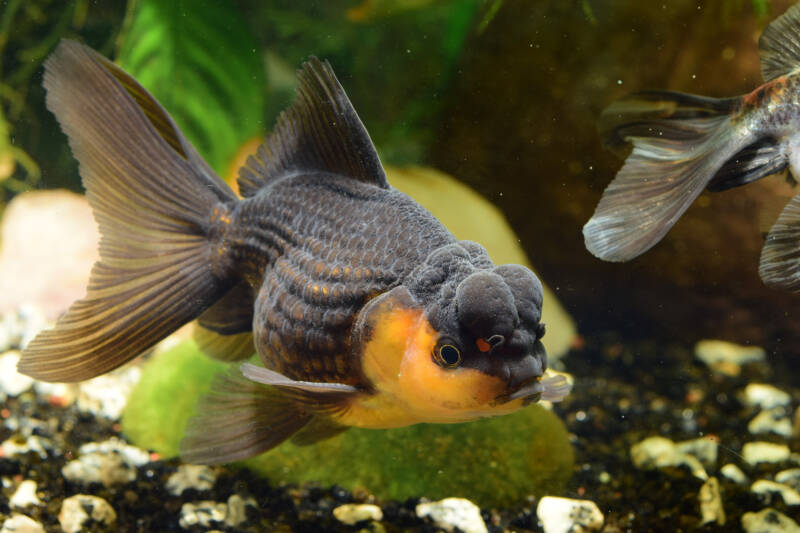On first sight of the pearlscale goldfish, one is struck by their unique beauty.
Lustrous, pearly scales; a rounded, plump shape; flowing fins; and large, expressive eyes give this fish a look like no other.
They are a developed goldfish species, first seen in China and then further developed in Japan around the 1950s.
Their unique shape leads to some interesting common names, including the golf ball or ping pong goldfish.

Good looks aside, these fish are peaceful and want nothing more than to cruise around exploring their tank and maybe dig a little to search for food.
Pearlscales are easy to care for; however, there are some things to be aware of before bringing one home to ensure you have the right environment for them to thrive.
Read on for information on setting up your tank the right way and how to feed this wonderful fish properly.

At a Glance
| Tank Size: | 20 gallons |
| Group Size: | Singly or in groups |
| Water Temperature: | 65 – 75°F (18 – 24°C) |
| pH: | 6.5 – 7.5 |
| Hardness: | 4 – 20 dKH |
| Lifespan: | 5 – 10 years |
| Breeding: | Egg layer |
| Adult Size: | 6 – 8 inches (15-20 cm) |
| Usual Place in the Tank: | Middle to bottom |
[toc]
Natural Habitat
The pearlscale (Carassius auratus) is a developed goldfish breed, and thus, does not have a “natural habitat.”
Their preferences are passed down from a long history of aquarium keeping.
This breed, like other goldfish, tolerates a range of cooler water temperatures.
They thrive in both indoor aquariums and outdoor ponds if steady water temperature, pH, and hardness are maintained.
Due to their anatomy and poor swimming ability, they prefer slow-moving, well-planted waters.
Appearance and Biology
Pearlscales are considered a “fancy goldfish” breed in the Cyprinidae family.
The first thing you may notice is that these fish have a deeply rounded belly that grows even more so as they age.
This belly is covered with nacreous scales, which are a combination of translucent and reflective tissues.
The scales give off a pearl-like gleam and lend the breed its name. Deposits of calcium carbonate give the scales a raised look.
Young pearlscales do not have large bellies and unique scales at first.
Easily mistaken for fantail goldfish at this point, they do not develop round bellies and pearly scales until they are around eight months old.
Color Variations
Unlike some goldfish varieties, pearlscales come in a range of colors.

Calico or orange-red are pretty standard, but you can also find them in solid colors, blue, and even chocolate.

On some variations, the tail fin is deeply forked.

Pearlscale Head Shape
The head of this fish can be shaped in two different ways.
The first shape is similar to a standard goldfish.

Next is the crown pearlscale variant, with a high, bulbous forehead.
Sometimes confused with and similar in appearance to the oranda goldfish.

This fish has bubble-like growths on its head and/or cheeks, ranging from small to quite large, single or double.
Lesser seen variants include those with fringe tails and telescope eyes.
Size
A pearlscale goldfish can reach a length between six to eight inches (15-20 cm).
Lifespan
While a common goldfish can live for more than 20 years, the pearlscale, like many other breeds of fancy goldfish, has a shorter lifespan.
A well-cared-for pearlscale can live five to ten years.
Their lifespan depends heavily on the care they receive.
As we will go into later, these fish are prone to illness due to their anatomy, and substandard care can reduce their lifespan significantly.
Behavior
Friendly and easygoing toward their tank mates, pearlscales make excellent community tank residents.
Due to their flowing fins and slow swimming, they are more prone to being picked on than they are to being the bully.
They visit all tank levels, but their body shape leads to poor swimming ability and can make it challenging to do so, especially as they age, and their bellies grow larger.
At that point, they will spend most of their time closer to the mid and bottom levels.
How many per gallon?
Plan on a minimum tank size of 20 gallons for a single fish. Add 10 gallons for each additional fish.
Tank Setup
The key to setting up a tank for your pearlscale is to start with a large enough tank and avoid sharp edges.
Decorations
Line the tank bottom either with a sandy substrate or smooth gravel.
Select a larger gravel size so that your pearlscale cannot ingest them as they root around.
Decorations that are hard or have sharp edges can hurt your goldfish.
Keep in mind that this species can knock off its elevated scales by bumping into hard objects.
While the scales grow back, they will no longer be elevated and pearlescent.
Avoid rocks or hard-edged decorations and go for driftwood and plants instead.
When selecting plants, choose those that tolerate cold water. Some favorites are java fern, hornwort, anacharis, and anubias.
Water Conditions
These fish tolerate a range of cool water temperatures, from 65 – 75°F (18 – 24°C).
Thus, they can live in outdoor ponds if a steady water temperature is maintained.
Keep the pH between 6.5 to 7.5 and avoid quick fluctuations. These fish do best in a water hardness between 4 and 20 dKH.
Pearlscale goldfish are prone to health issues in sub-optimal water conditions.
Test your water regularly to ensure the temperature and pH are consistent. Change out 25 percent of the water every week to prevent the buildup of nitrates and ammonia.
Equipment
Any filter you install should be strong enough to handle the tank’s bioload but not produce too much current flow.
A hang on back filter is good for smaller tanks; consider a canister filter for larger ones.
Pearlscales need a good amount of oxygen in the water as well, so consider an air stone or select a tank size that is longer to increase the water surface area and allow for an exchange of gasses.
Regular water changes will help to maintain oxygen levels in addition to keeping the water clean.
Tank Mates

The rounded shape of this species makes it difficult for them to swim. Plus, they have tempting, flowing fins.
Care should be taken to not pair them with fish that would take advantage of these things.
The ideal pairing for the pearlscale is other fancy goldfish.
Some species of goldfish are fast swimming, however, and would not be a compatible match.
Consider these species to pair with your pearlscale goldfish:
- Other fancy goldfish
- Bubble eye
- Black moor
- Veil tails
- Lionhead
- Peaceful, slow swimming fish
- Fish that tolerate the same cooler water conditions
- Snails (nerite or mystery)
Avoid the following:
- Fast swimming, aggressive fish, including some goldfish
- Fish that are fast eaters (your pearlscale will not be able to get enough to eat)
- Known fin nipping species, such as tetras
Food and Diet
Pearlscales are omnivores, which means they love a variety of food. However, there are a few things to keep in mind when feeding them.
Their intestines are compressed due to their anatomy.
This makes them prone to blockage, which can lead to swim bladder disease.
To help prevent this, feed your pearlscale a varied diet that includes a good amount of vegetables.
Flakes are fine occasionally but do not make them the base of their diet. Any flakes should be pre-soaked to aid in digestion.
Give your fish calcium-fortified sinking pellets, steamed vegetables such as peas and cucumbers, and the occasional live food treat.
Brine shrimp are always a hit, but limit protein intake to 30 percent of their diet.
Feed your fish twice per day and only as much as they can consume in two minutes.
Breeding
Pearlscale readily breed in an aquarium setting. Set up the proper environment, and let nature take care of itself.
Setting up a Breeding Tank
Dedicate a separate 20-gallon (90 l) tank for breeding. Include a spawning mop or live plants to protect the eggs.
Plan to change out about 20 percent of the water each day.
Spawning
Place your breeding pair in the tank and feed them three times a day. Offer more live foods, such as brine shrimp.
Slowly lower the water temperature to around 60°F, then gradually raise the temperature each day by three degrees.
Your fish should spawn once the temperature is around 68 to 74°F (20-23°C).
You may observe a mating ritual wherein the male chases the female around the tank. Both fish will show more vivid coloration.
Afterward, the female can lay 1,000s of eggs against the plants or spawning mop.
Take the parents out of the tank once spawning is complete to avoid them eating the eggs.
Caring for the Fry
The eggs should hatch after five days. Newly born fry will stay with their egg sacs for nutrition for the next few days.
After that, you can begin feeding them powdered fry food or infusoria until they are large enough to eat brine shrimp.
The fry and young will not show the rounded belly or pearly scales until they are around eight months old.
Wait until they are at least an inch (2.5 cm) in length before introducing them to the community tank.
Hardiness
As we have mentioned, this breed is prone to swim bladder disease if they are not fed the proper diet.
This tendency can increase as they age and their stomach grows.
Poor water conditions make them more susceptible to common freshwater tank ailments, especially fin rot.
Their long fins can become severely damaged by this, so it is best to keep up water conditions.
Frequently Asked Questions
Can pearlscale goldfish live in ponds?
Yes! Provided you keep the water parameters within their range.
This means that during the winter months, these fish may need to be brought indoors if the water temperature will stay below 55°F (13°C).
Monitor the water for ammonia and nitrate levels as well to ensure optimal health of your pearlscale.
Closing Thoughts
The pearlscale is a lovely and unique addition to a home aquarium or outdoor pond.
The time spent setting up the right environment and feeding these fish properly is well worth it.
These cuties will undoubtedly bring joy as they flutter around, casually exploring their environment.
Let’s hear from you!
How long have you kept pearlscale? What was your experience?
